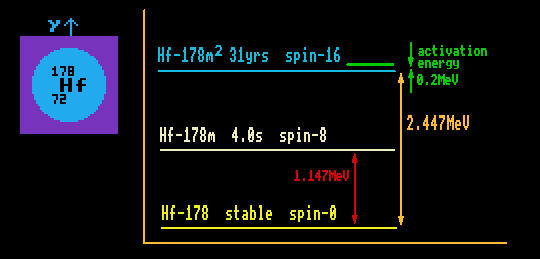

Hafnium-178m2 has a prolate nucleus and a high spin of 16 units. The halflife of this excited state is 31 years, and it decays by losing all this excess spin to the ground state, a spin-0 state. The spin of 16 units is carried by just 4 un-paired nucleons which orbit the nucleus. The energy difference between this excited metastable state and the ground state to which it decays is a high 2.447 MeV, and it does this by emitting gamma rays. But this decay is highly inhibited by the need to remove 16 spin units simultaneously by the emission of several simultaneous gamma rays. It is a so-called spin-trap isomer.
However, just as light can stimulate the emission of more light within a laser, so too can X-rays stimulate the decay of Hf-178m2 to its ground state, Hf-178, losing all it's spin (and excess energy) as gamma rays. The energy of the X-rays needed to stimulate Hf-178m2 to decay to the ground state is 0.2 MeV and is called the activation energy. This is a quantum nucleonic reactor. The energy released is 100 times more than the energy needed to produce the stimulating X-rays, so there is a huge net energy release. This energy can be used to generate thrust by heating air to produce a jet, which could be used to propel a craft for months on end without needing to re-fuel. The US military is considering the use of such an engine within un-manned reconaissance drones.
The beauty of this system, is that, although Hf-178m2 is radioactive with a half-life similar to caesium-137, it is somewhat self shielding. Also, once the X-ray source stops irradiating the metal, the radioactivity drops sixty-fold. So although you wouldn't want to pick up the object, it is nowhere near as dangerous as a conventional fission reactor.
![]()